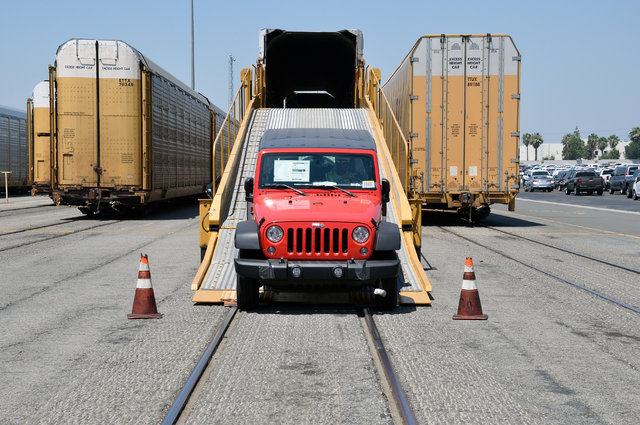October 12, 2021
How to Load and Unload Rail Cars
Rail cars can carry just about anything: cars, clothes, lumber, liquor, food, fertilizer, grains, gas and so much more. And they can hold a lot of those products, on average carrying 3-4 truckloads per rail car. So while there is no doubt that you can ship just about any type of freight by rail, the question becomes this: How do those products get into and out of rail cars?
The answer depends on what product you are shipping and in which type of rail car. Here’s an inside look at how each rail car type is loaded and unloaded.

How Are Autoracks Loaded and Unloaded?
Vehicles are driven on and off auto racks using portable ramps. First, auto ramp operators open the doors at one end of the autorack. Then, the ramp pulls up to that end of the autorack and is secured to the level to be unloaded. Once the ramp is securely in place, cars, trucks and SUVs can be driven safely (and slowly) into or out of the rail car.
Inside an autorack, each wheel of the vehicle is secured to the rail car with special straps or chocks to keep it in place during transit. Before unloading, these straps and chocks must be moved before vehicles can be driven off.
How Are Boxcars Loaded and Unloaded?
Most often, forklifts or other mechanical devices are responsible for loading and unloading boxcars. Occasionally they may be loaded and unloaded by hand.
Where are products loaded into and out of boxcars? Most boxcars have a door in the center or middle of the car through which products can be put in and taken out.
How Are Centerbeams Loaded and Unloaded?
Centerbeam rail cars are usually loaded with forklifts. Both sides of the centerbeam must be loaded at the same time or the rail car will be at risk of tipping over. Loading and unloading both sides of a centerbeam simultaneously ensures the weight of the shipment is distributed evenly across the car and also makes for a faster loading and unloading process.
How Are Coil Cars Loaded and Unloaded?
Typically, overhead cranes or forklifts are used to load and unload steel coils from coil cars.

How Are Covered Hoppers Loaded and Unloaded?
Covered hoppers are loaded from above the rail car. Because covered hoppers have round, trough or hybrid hatches on top, these must be opened before product is loaded into the rail car. After loading, hatches are closed again to protect the contents of the hopper during transit.
Covered hoppers rely on gravity for unloading. Because covered hoppers have sloped floors with doors at the bottom, product flows through easily when the doors are opened. This method of unloading is referred to as the “sliding gate” or “self-clearing” method.
Food-grade covered hoppers can be loaded and unloaded the same way as traditional covered hoppers but they can also be loaded and unloaded via pneumatic transfer. Loading and unloading food-grade hoppers this way keeps food-grade products extra safe from potential contaminants.

How Are Flatcars Loaded and Unloaded?
Cranes and forklifts are the most common way to load and unload a flatcar, but the method may vary depending on the type of freight being shipped. Pipe or rails are usually loaded and unloaded with a crane or other mechanical device, while military equipment, heavy construction equipment, and farm equipment can be driven on and off flatcars.
How Are Gondolas Loaded and Unloaded?
Gondolas are typically loaded and unloaded by a crane or backhoe, but steel is usually loaded and unloaded using a claw magnet.
How Are Intermodal Containers and Trailers Loaded and Unloaded?
Intermodal containers and trailers have double doors at the back end through which products can be loaded and unloaded. Palletized products are loaded with forklifts, but the method will vary based on product type.
How Are Open-Top Hoppers Loaded and Unloaded?
Open top hoppers are loaded from the top and unloaded from the bottom. Because these rail cars are open at the top, bulk commodities can be poured into the length of the rail car. Open-top hoppers are unloaded the same way as covered hoppers: using sloped floors and doors that slide open at the bottom, products are discharged quickly using gravity.
How Is a Tank Car Loaded and Unloaded?
If a tank car is pressurized, loading and unloading happens through secure valves with a protected housing. If the tank car is not pressurized, it will be equipped with an outlet at the bottom through which product can flow.

How Are Well Cars Loaded and Unloaded?
Container cranes (also known as gantry cranes) lift containers on and off well cars. When a well car carriers two containers stacked on top of each other, the top container is secured to the bottom one. Containers must then be unlocked before being unloaded.
Learn More
If you want to learn more about how to ship by rail, get in touch. Or, learn more about the various rail car types.
Related Articles
- How to Clean and Inspect Rail Cars
- Which Reefer Unit Is the Best for Shipping Perishable and Frozen Goods?
- Quiz: Is Rail the Right Fit for Your Shipments?
- How to Ship Oversized Freight
- How to Keep Intermodal Shipments Safe
- How Does Train Dispatching Work?
- The Art of Loading a Rail Car
- Rail 101 FAQs
- How Do Rail Cars Move?
- Transportation Modes Revealed: A Comprehensive Look